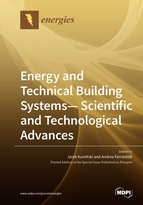Energy and Technical Building Systems - Scientific and Technological Advances
A special issue of Energies (ISSN 1996-1073). This special issue belongs to the section "G: Energy and Buildings".
Deadline for manuscript submissions: closed (31 October 2019) | Viewed by 39291
Special Issue Editors
2. Department of Civil Engineering, Aalto University, PO Box 12100 FI-00076 Aalto, 02150 Espoo, Finland
Interests: energy performance and indoor climate analysis of buildings and systems; low energy and nearly zero energy buildings; microbial growth and moisture safety aspects in buildings; innovative HVAC and energy systems and building simulation; technical definitions for NZEB buildings and energy calculation frames for regulation; sustainability assessment criteria and methods for buildings and construction
Special Issues, Collections and Topics in MDPI journals
Interests: heat transfer; theoretical modelling; building simulation; energy performance; thermal comfort
Special Issues, Collections and Topics in MDPI journals
Special Issue Information
Dear Colleagues,
Future buildings have not only to be energy efficient, but they need to be equipped with proper building automation and control systems’ functionalities in order to be capable to respond to the needs of occupants and energy grids. These development paths, raised by the revised Energy Performance of Buildings Directives as a new smart readiness indicator, require one to focus more on occupant needs such as good indoor climate, easy operability, and the monitoring of buildings. Another area to be tackled is energy flexibility, which is needed to make buildings responsive to price signals of electricity grids with increasing amounts of fluctuating renewable energy generation both installed in central grids and on building sites. This Special Issue follows ten domains of the smart readiness assessment scope, namely, the following:
- Heating;
- Domestic hot water;
- Cooling;
- Mechanical ventilation;
- Lighting;
- Dynamic building envelope;
- On-site energy generation;
- Demand side management;
- Electric vehicle charging;
- Monitoring and control.
Research and review papers within these ten domains, with the aim to improve building energy performance, indoor climate, operation, commissioning, and maintenance and energy flexibility, are welcomed.
Prof. Dr. Jarek Kurnitski
Dr. Andrea Ferrantelli
Guest Editors
Manuscript Submission Information
Manuscripts should be submitted online at www.mdpi.com by registering and logging in to this website. Once you are registered, click here to go to the submission form. Manuscripts can be submitted until the deadline. All submissions that pass pre-check are peer-reviewed. Accepted papers will be published continuously in the journal (as soon as accepted) and will be listed together on the special issue website. Research articles, review articles as well as short communications are invited. For planned papers, a title and short abstract (about 100 words) can be sent to the Editorial Office for announcement on this website.
Submitted manuscripts should not have been published previously, nor be under consideration for publication elsewhere (except conference proceedings papers). All manuscripts are thoroughly refereed through a single-blind peer-review process. A guide for authors and other relevant information for submission of manuscripts is available on the Instructions for Authors page. Energies is an international peer-reviewed open access semimonthly journal published by MDPI.
Please visit the Instructions for Authors page before submitting a manuscript. The Article Processing Charge (APC) for publication in this open access journal is 2600 CHF (Swiss Francs). Submitted papers should be well formatted and use good English. Authors may use MDPI's English editing service prior to publication or during author revisions.
Keywords
- Heating
- Domestic hot water
- Cooling
- Mechanical ventilation
- Lighting
- Dynamic building envelope
- On-site energy generation
- Demand side management
- Electric vehicle charging
- Monitoring and control







